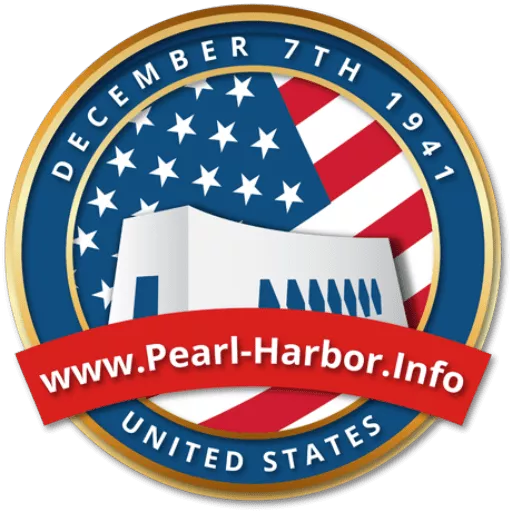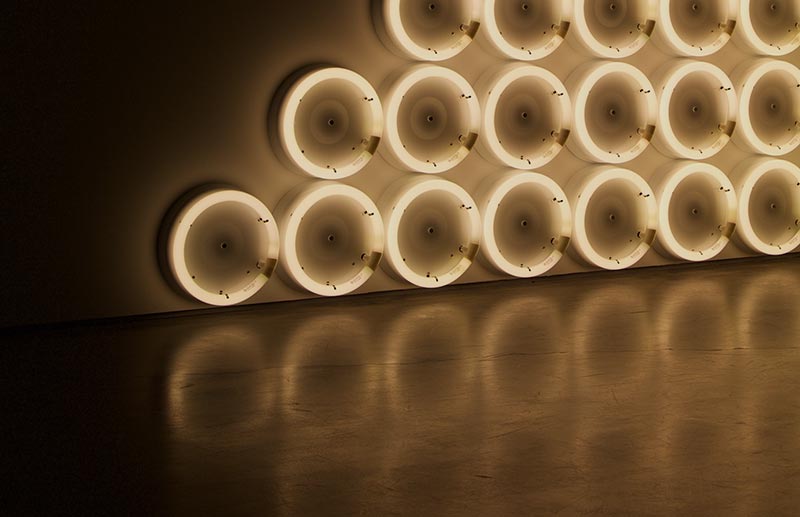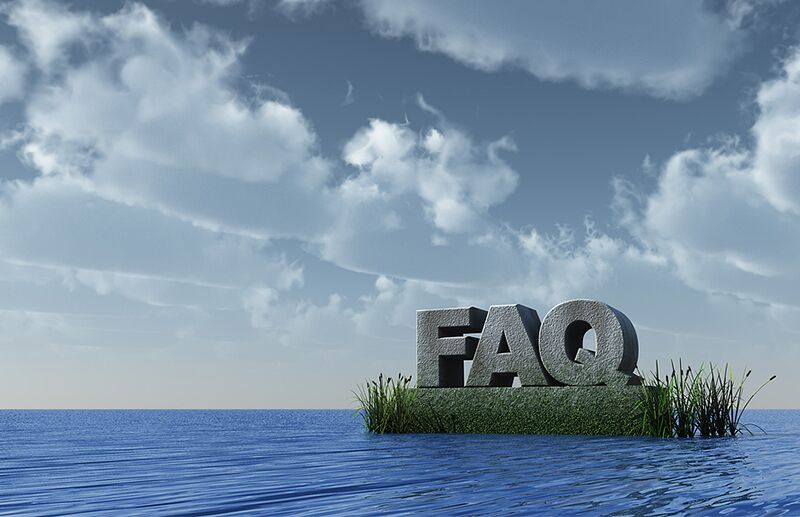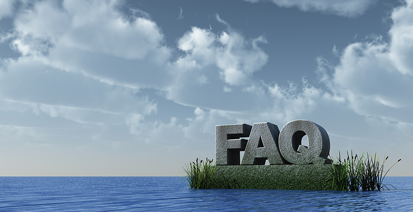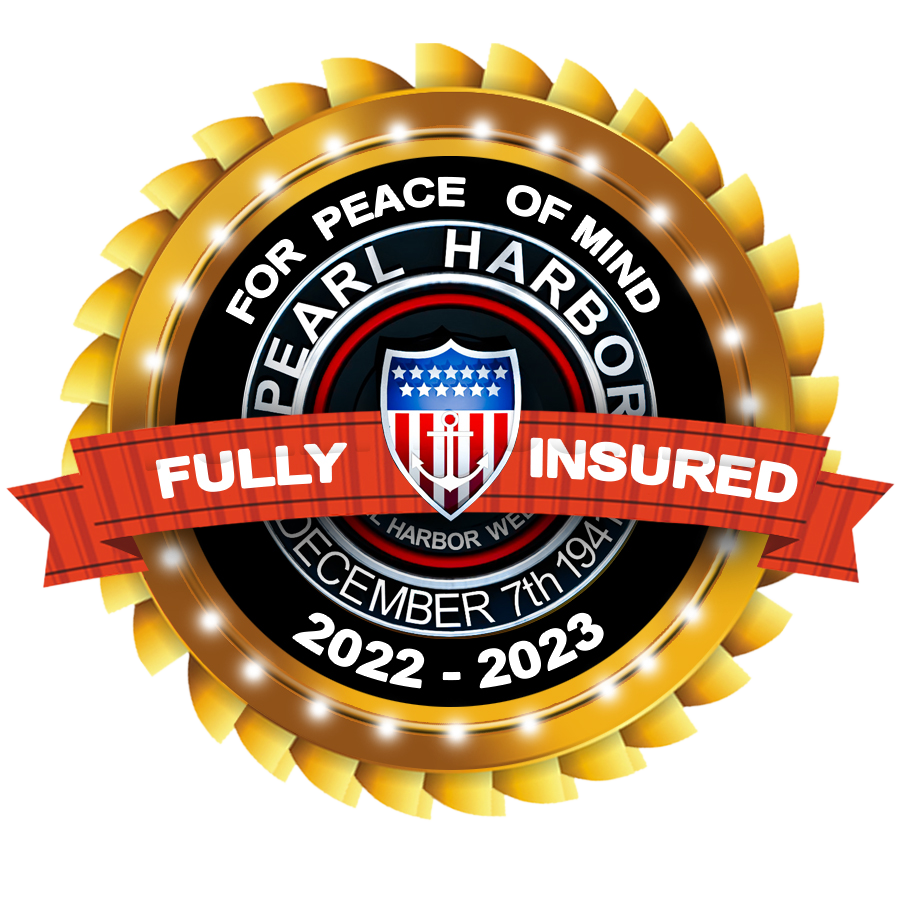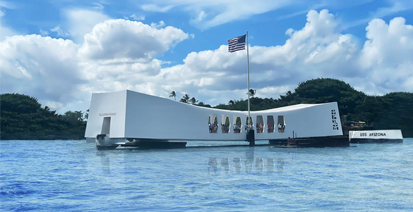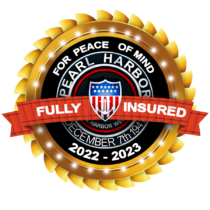The Atomic Bombing Of Hiroshima And Nagasaki
Events Leading to the Atomic Bombings

Japanese nurses on way to French Battlefields - Seventeen Japanese nurses, under the leadership of Doctor J. Suzuki, photographed in New York on route from Tokio to French Battlefields, Omaha daily bee, PS-US
During World War 1, Japan was part of the Allied coalition, and she was awarded the Islands of Tinian and Saipan after the war with Germany. Japan made these Islands their colonies and started to grow sugar on them as their primary industry.
Near Saipan was the Island of Guam, just 135 miles away, and the US took over Guam from Spain after winning the Spanish/American War of 1899.
The day after the bombing of Pearl Harbor on Dec 7, 1941, the Japanese military and their Saipan guides invaded Guam and quickly acquired the Island for its expanding Empire. Since Guam was a territory of the United States, the captured US service members were treated inhumanely, and approximately 15 percent of the population was killed. Today there is a large museum on Guam that showcases the Japanese atrocities and brutal military occupation of Guam during WWII.
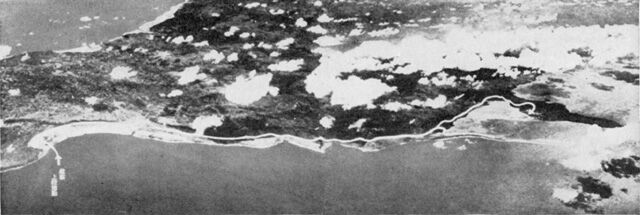
“Japanese Naval Task Force landing site at Dungcas Beach on 10 December 1941 and the route through Agana to Orote Peninsula is shown in this picture from an illustrated review of Japanese naval operations. (Army Photograph.)” Source: http://www.ibiblio.org/hyperwar/USMC/USMC-M-Guam/img/USMC-M-Guam-p8.jpg, Palm dogg at en.wikipedia, Transferred from en.wikipedia by SreeBot, PD-US

Aerial photograph of the Japanese aircraft carrier Sōryū during the Battle of Midway. The ship was circling as an evasion maneuver while under attack from United States Army Air Forces Boeing B-17E Flying Fortress bombers from Midway Island, shortly after 08:00h, 4 June 1942., United States Army Air Forces (USAAF), United States Library of Congress’s Prints and Photographs division under the digital ID fsa.8e00397, PD_USGov
For over a year, the Japanese military conquered one nation after another and swept through Asia and the Pacific. The two turning points of the War in the Pacific were:
- In The Battle of Midway on June 4, 1942, Japan lost four mightiest aircraft carriers, 300 planes, and 2,500 of some of their best sailors. No longer could Japan dominate the Pacific after this tremendous naval defeat.
- The Battle of Guadalcanal ended in Feb of 1943. The Japanese army lost 30,000 men, their air force lost over 600 planes, and 24 of their Navy warships sank. This battle stopped the Japanese expansion in the Pacific and secured the communication and shipping lines for the Allies with Australia.
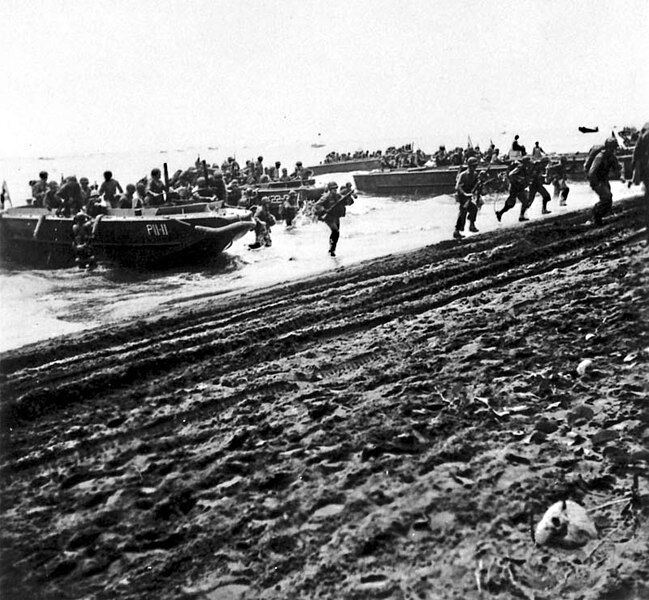
U.S. First Division Marines storm ashore across Guadalcanal’s beaches on D-Day, 7 August 1942, from the attack transport USS Barnett (AP-11) and the attack cargo ship USS Fomalhaut (AK-22). The invaders were surprised at the lack of enemy opposition., U.S. Marine Corps, U.S. National Archives photo 80-CF-112-5-3 from First Offensive: The Marine Campaign For Guadalcanal. Marines in World War II Commemorative Series, PD_USGov
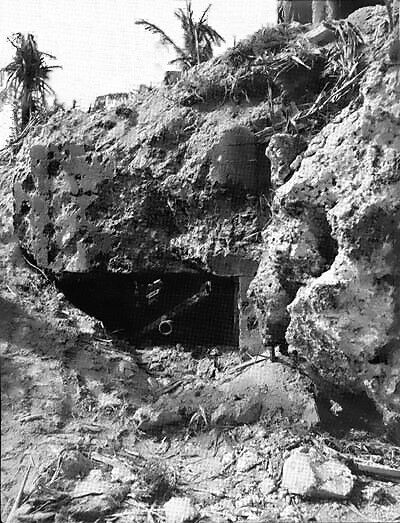
A threatening 75mm Japanese gun pokes its barrel out of the Gaan Point pillbox where a companion piece and a 37mm gun wreaked havoc on the assault waves of the 22d Marines on W-Day, destroying approximately 24 troop-carrying amphibian tractors, before the enemy position was taken out. Post-Work: User:W.wolny, National Park Service - (Department of Defense Photo (USN) 247618), PD-USGov
As the US and her Allies started taking back Islands in the Pacific, Japan turned its attention to fortifying Guam, Tinian, and Saipan into military fortresses. Japan knew that if they lost these strategically located islands, the US and their Allies could use the Islands to bomb Japan with their land-based aircraft. These islands became the last defense of Japan’s central Pacific perimeter.
The US estimated that taking these three Islands would take a lot of firepower and personnel and sent a fleet of 535 warships and an invasion force of 127,000 service members. The Battle of Saipan began on June 15, 1944, and lasted for 24 days, resulting in 30,000 Japanese soldiers being killed along with all four of their commanders and 480 of their aircraft being destroyed. The US forces lost 3,000 service members and over 10,000 wounded.
So many US personnel were lost on Saipan that after the war, the US dedicated the 400-acre American Memorial Park, which is adjacent to the central city of Garapan. The National Park Service and its non-profit Pacific Historic Parks run and help maintain the Park for the citizens of Saipan.

These marines were in good spirits as they moved through the ruins of Garapan on up to the front lines to help wind up the battle of Saipan island. July 6, 1944., User:W.wolny, National Park Service - (USMC # 84977, National Archives), PD_USgov
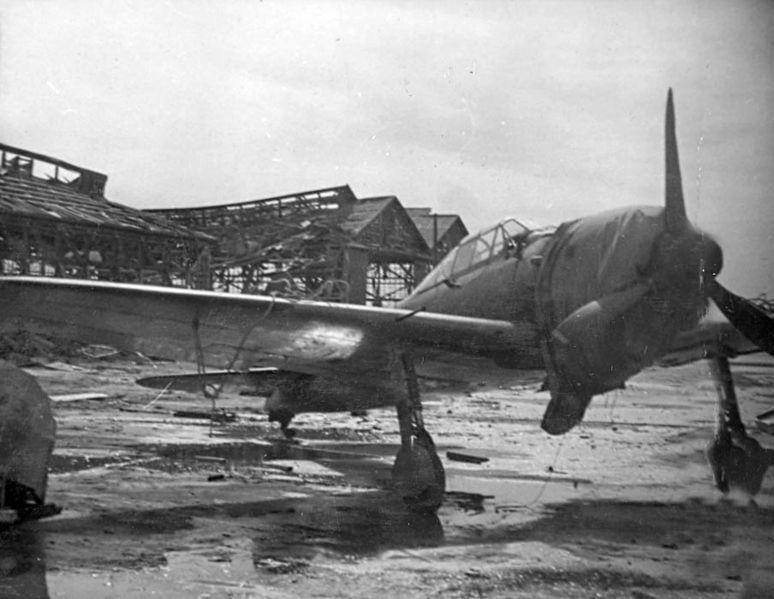
A captured Mitsubishi A6M5 Zero fighter on a Japanese airfield on Saipan in the Mariana Islands., U.S. Navy (The photo is part of a scrapbook assembled by CDR William H. Balden, USNR, documenting his World War II service)., U.S. Navy National Museum of Naval Aviation photo No. 2007.084.001.236, PD-USGov
Once the US Marines took the Saipan’s airfields, they immediately launched the invasions of Tinian and Guam. Guam was the larger of the two islands and gave the most resistance, which ended on August 10. 1944. Japan lost with approximately 18,500 killed and 1250 soldiers wounded, and the US lost over 1.800 service members killed and 6,000 wounded.
Airfields in Saipan, Tinian, and Guam were expanded, and US bombers flew on a battle mission to Japan every 15 to 20 minutes until the war’s end. Because the Japanese cities were made of wood, incendiary bombs would cause giant firestorms that would destroy most of a town, 64 of Japan’s largest cities were targeted for these missions.
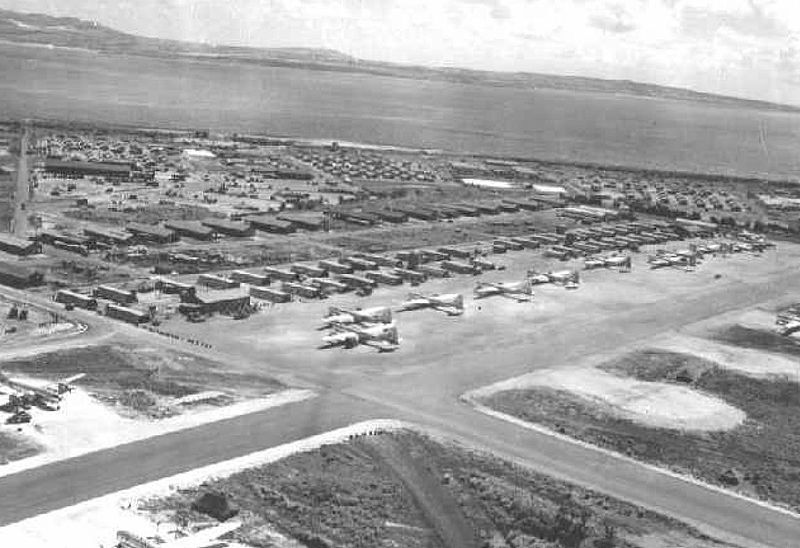
West Field, Tinian - B-29s on parking ramp, USAF Historical Research Agency, PD-USGov
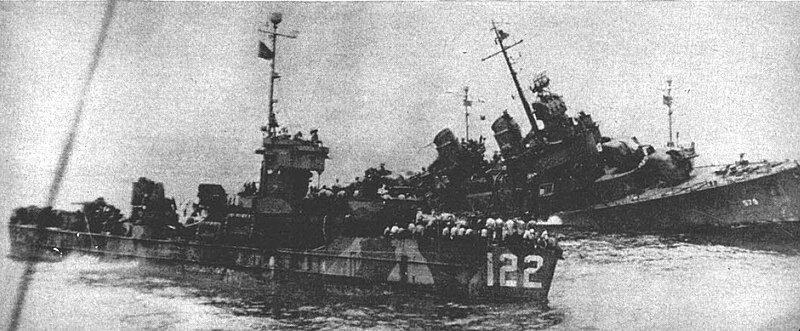
The U.S. Navy destroyer USS William D. Porter (DD-579) sinking after she was near-missed by a Kamikaze suicide aircraft off Okinawa, 10 June 1945. USS LCS-122 is standing by, U.S. Navy, U.S. Navy All Hands magazine August 1945, PD-USGov
Hiroshima
After the significant battles of Saipan, Guam, Philippines, Iwo Jima, and Okinawa, the US knew the fanaticism of the Japanese military. With the end of the European war ending on May 8, 1945, US’s full attention was on ending the War in the Pacific. The US Military Intelligence estimated that an invasion of Japan could take years and cost the Allies between 1.7 to 4 million casualties and 800,000 dead service members. As a result of these predictions, President Franklin D. Roosevelt and his top military commanders decided to use their new atomic weapon against the Japanese. England and Canada were advised, and they agreed with the military decision.
On July 26, 1945, an ultimatum was given to the Japanese Emperor and its military commanders for “unconditional surrender or suffer prompt and utter destruction”; otherwise, the US would release a new type of weapon upon a major Japanese city. The Japanese chose to ignore the ultimatum.

The U.S. Navy destroyer USS William D. Porter (DD-579) sinking after she was near-missed by a Kamikaze suicide aircraft off Okinawa, 10 June 1945. USS LCS-122 is standing by., U.S. Navy, U.S. Navy All Hands magazine August 1945, p. 13., PD-USGov
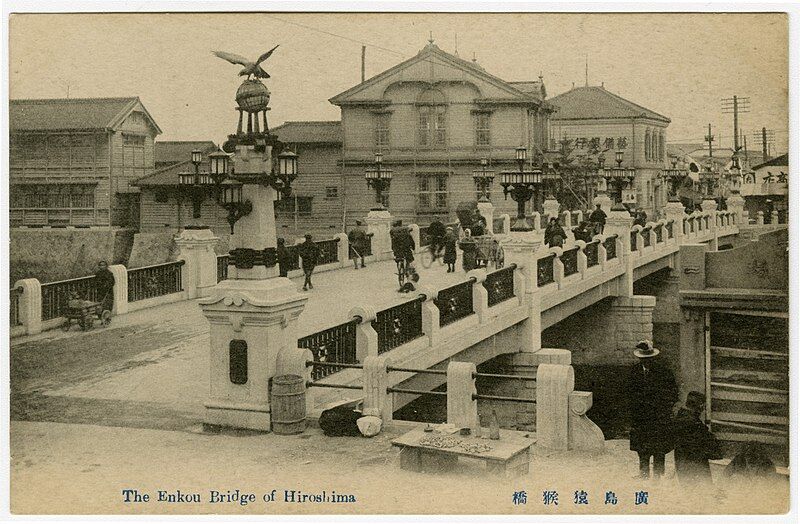
日本語: 広島市の猿猴橋, 広島□○堂, 広島市公文書館デジタルギャラリー(フリーダウンロード)https://www.city.hiroshima.lg.jp/soshiki/5/170625.html, PD-JPN, PD-US
Hiroshima was chosen because of its large urban areas, industrial factories, and military facilities. This new atomic weapon was top secret and massive in size; it was decided to use the Island of Tinian as the launching airfield. A huge hole was dug in the runway, and large electronic jacks were used to lower the bomb into its hole. The bomber aircraft’s name was Enola Gay, and she was back over the hole, and the atomic bomb was lifted and secured to the bomber’s underside. Their crew knew they would have a six-hour flying time to their Japan target, and two other B-29s accompanied her.
On August 8, 1945, “Little Boy,” an enriched uranium fission bomb, was dropped on Hiroshima with truly devastating results; over 129,000 people died in the blast, and thousands died later from their burns and radiation poisoning. Because the bomb detonated in the air, the radius of destruction was 1.5 miles in each direction, with fires reaching out 4.5 miles, resulting in 70 percent of all Hiroshima buildings being flattened.
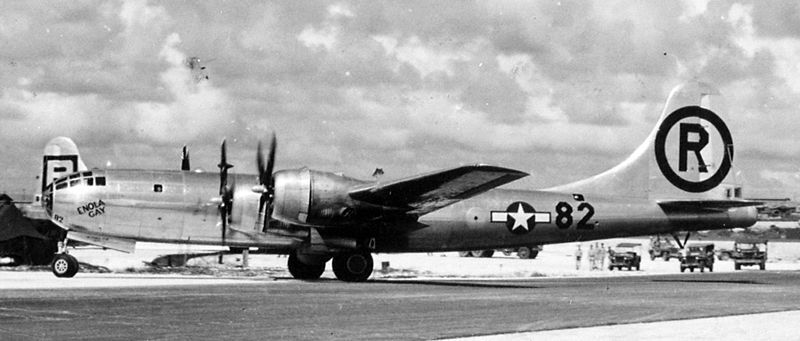
Enola Gay, The original uploader was Veinsworld at German Wikipedia., http://www.af.mil/shared/media/photodb/photos/020905-o-9999g-005.jpg, PD-US
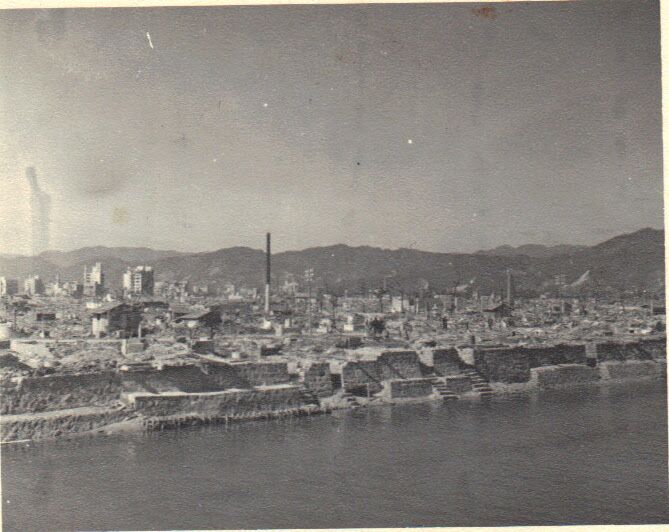
Hiroshima after the Atom Bomb Strike 1945 taken by sailors of USS Tuscaloosa, Sailor on the USS Tuscaloosa, Hiroshima after the Atom Bomb Strike 1945 taken by sailors of USS Tuscaloosa, PD-USGov
Nagasaki
After the bombing of Hiroshima, President Roosevelt went on the radio and announced the use of the US’s new weapon; he acknowledged that if our enemies had developed it first, it would have been used against our country to end WWII. He again called for the Japanese unconditional surrender or “continue to expect a rain of ruin from the air.” This was a widely delivered speech in the US, and it was intercepted by the Japanese military and their news outlets.
For the next three days, Prime Minister Suzuki of Japan refused the request for surrender. Thus, the US President and his top military commanders decided to select another major Japanese city and chose Nagasaki due to its vast naval bases.

Panorama van de haven van NagasakiNagasaki Harbour (titel op object), Rijksmuseum, http://hdl.handle.net/10934/RM0001.COLLECT.264821, CC0 1.0
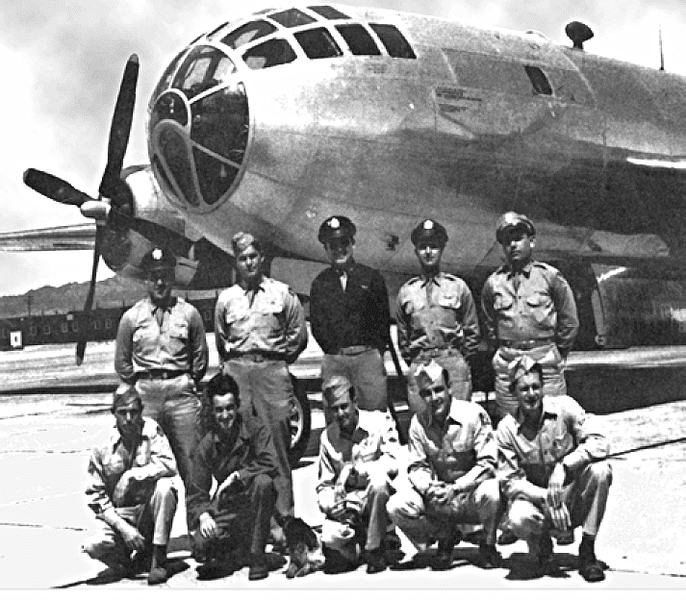
Enlisted flight crew of the Bock's Car., ASAF, http://www.historytoday.com/alonzo-hamby/truman-and-bomb, PD-USGov
On August 9, 1945, another US bomber left the Island of Tinian for Japan with “Fat Boy,” a plutonium implosion-type nuclear bomb, resulting in 226,000 casualties and the destruction of Nagasaki. This bomb was more powerful than “Little Boy,” but due to the drop’s hilly location, the destruction radius was just under a mile, causing fires that spread throughout the wooden city by high winds. Like Hiroshima, Nagasaki was destroyed beyond recognition.
Japan Surrenders
Shocked by the destruction of Hiroshima and Nagasaki, the Emperor of Japan and his top military generals surrendered on August 15, 1945. A few days later, the Soviet Union declared war on Japan.
On Sept 2, 1945, the government of Japanese signed the instrument of surrender on the USS Missouri Battleship, effectively ending World War II.
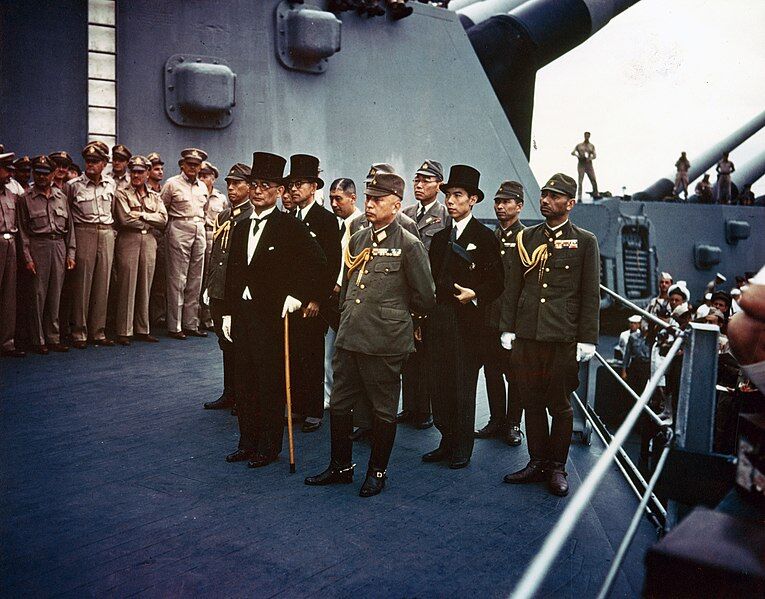
Surrender of Japan, Tokyo Bay, 2 September 1945: Representatives of the Empire of Japan on board USS Missouri (BB-63) during the surrender ceremonies., Army Signal Corps, Naval Historical Center Photo # USA C-2719. Photograph from the Army Signal Corps Collection in the U.S. National Archives, PD-USGov,

The Saipan American Memorial is located near the beach overlooking Tanapag Harbor on the Island of Saipan, Commonwealth of the Mariana Islands. It is a part of the American Memorial Park commemorating the Americans and Chamorro who died during the liberation of the Mariana Islands during World War II. Specifically, the memorial honors the 24,000 American marines and soldiers who died recapturing the islands of Saipan, Tinian and Guam during the period June 15, 1944 to August 11, 1944., Post-Work: User:Staffus, American Battle Monuments Commission, PD-USGov
So many US personnel were lost in the battle for Saipan and Guam that after the war, the US dedicated the 400-acre American Memorial Park in Saipan, which is in the central city of Garapan. On Guam, other War Memorials were established during significant battles. To this day, National Park Service and its non-profit Pacific Historic Parks run and help maintain these Saipan and Guam parks, memorials, and visitor centers.
